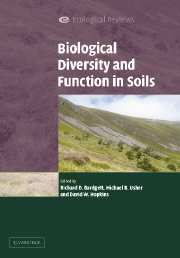Book contents
- Frontmatter
- Contents
- List of contributors
- Preface
- Acknowledgements
- PART I Introduction
- PART II The soil environment
- PART III Patterns and drivers of soil biodiversity
- PART IV Consequences of soil biodiversity
- PART V Applications of soil biodiversity
- PART VI Conclusion
- 20 Underview: origins and consequences of below-ground biodiversity
- Index
- References
20 - Underview: origins and consequences of below-ground biodiversity
Published online by Cambridge University Press: 17 September 2009
- Frontmatter
- Contents
- List of contributors
- Preface
- Acknowledgements
- PART I Introduction
- PART II The soil environment
- PART III Patterns and drivers of soil biodiversity
- PART IV Consequences of soil biodiversity
- PART V Applications of soil biodiversity
- PART VI Conclusion
- 20 Underview: origins and consequences of below-ground biodiversity
- Index
- References
Summary
SUMMARY
The mechanistic origins and functional consequences of soil biodiversity, in terms of general principles and across a broad context, are reviewed.
The origins of below-ground biodiversity are discussed in terms of the spatial isolation that soil structure imparts, substrate diversity, competition and environmental fluctuation. Community structure is governed by many factors.
The consequences of soil biodiversity are explored in relation to the functional repertoire that the biota carries, the potential and realised interactions between components, and functional redundancy.
A wide variety of relationships are expressed between soil biodiversity and function. These are discussed in relation to resilience, the impact of biodiversity upon individual organisms, complexity, and above- and below-ground linkages.
Biodiversity per se, particularly in terms of species richness that prevails in most soils, is apparently of little functional consequence. The functional repertoire of the soil biota is considerably more pertinent.
Improved understanding of the relationships between soil community structure and function underpins the effective and sustainable management of ecosystems in an agricultural, forestry, conservation or restoration context. Knowledge is burgeoning and an improved understanding is following, but a unifying framework is currently elusive. Soil architecture may be the key.
Introduction
The aims here are to take an ‘underview’ of soil biodiversity within the broad context of the preceding 19 chapters, the presentations and discussions that ensued at the symposium on which this volume is based, and to discuss some additional concepts and issues that received less emphasis.
- Type
- Chapter
- Information
- Biological Diversity and Function in Soils , pp. 381 - 401Publisher: Cambridge University PressPrint publication year: 2005
References
- 3
- Cited by



